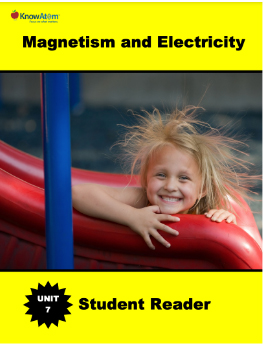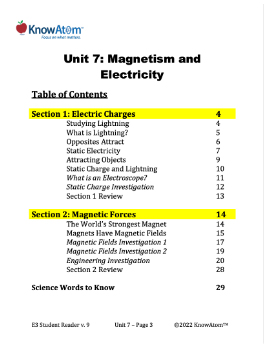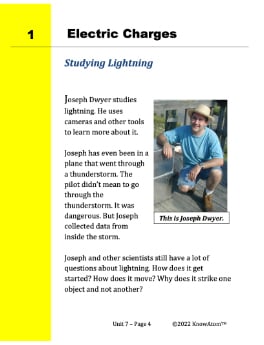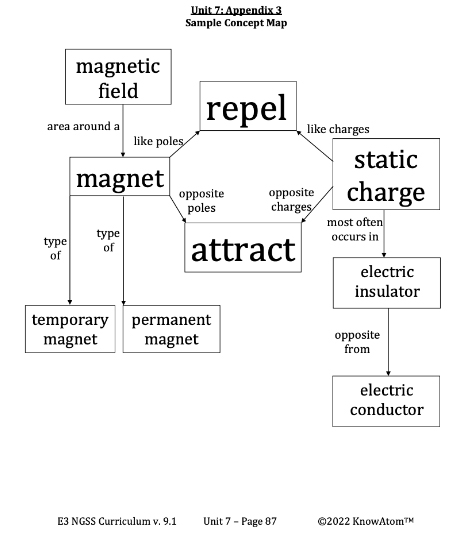In this lesson, students apply what they know about magnetic interactions to engineer a device that can pick up and place metal paper clips for a metal factory.
In this unit, students focus on science phenomena related to electric and magnetic forces. First, students explore how materials can become electrically charged and then attract or repel other materials without touching them. Then, in this lesson, students apply what they know about magnets and magnetic forces to design a device that can pick up and place metal paper clips for a metal factory. This page is a high-level extract of this lesson.
The science background provides teachers with more detailed information about the phenomena students explore in this unit.
Magnets are categorized by the origin of their magnetic fields. A natural magnet is a rock magnetized by Earth’s magnetic field. Any rock containing iron, such as magnetite, can be a natural magnet. The rock becomes magnetized over thousands of years as the electrons of the iron particles that make up a magnetite rock begin to spin in the same direction.
Human-made magnets are created artificially and can be permanent or temporary. Permanent magnets are usually made of iron or steel. They are “permanent” because once they are magnetized, they stay magnetized for a very long time. The strongest kind of permanent magnets are rare earth magnets, which are made from the rare earth elements neodymium or samarium.
In contrast, temporary magnets act like a permanent magnet when they are within a strong magnetic field. They lose their magnetism when the magnetic field goes away. They are created by repeatedly rubbing a metal object, such as a paper clip or iron nail, with an active magnet to align the object’s electrons.
The magnetic field of the horseshoe magnet attracts the iron-containing nail. Electrical current is also capable of creating a uniform electron spin. An electromagnet is a tightly wound coil of wire that produces a magnetic field when electricity passes through the wire. The strength of the magnetic field created by the electromagnet is adjustable by changing the voltage flowing through the wire, and by increasing or decreasing the amount of coils around the iron core. Reversing the flow of electricity reverses the poles of the electromagnet.
In this lesson, students apply what they know about magnetic interactions to engineer a device that can pick up and place metal paper clips for a metal factory.

Prepared hands-on materials, full year grade-specific curriculum, and personalized live professional development designed to support mastery of current state science standards.
Misconception: All metals are attracted to magnets.
Fact: Not all metals are attracted to magnets. Iron, cobalt, and nickel are the three naturally occurring metals that are attracted to magnets.
Misconception: Larger magnets are always stronger than smaller magnets.
Fact: A magnet’s strength depends on the materials that make it up. With two magnets of the same material, the larger magnet will be stronger than the small magnet. But in magnets made up of different materials, the smaller magnet may actually be stronger than the larger magnet.
Attract : to pull together
Repel : to push apart
Magnet : an object that produces a magnetic field; has a north and south pole; attracts or repels other magnets or magnetic materials such as iron
Magnetic Field : the area around a magnet that attracts or repels other magnets and magnetic materials such as iron
Permanent Magnet : an object that stays magnetized without electricity
Temporary Magnet : an object that acts like a permanent magnet when it is within a strong magnetic field
Magnets Have Magnetic Fields
A magnet is any object that produces a magnetic field. A magnetic field is the area around a magnet that attracts or repels other magnets or magnetic materials such as iron.
A magnetic field applies a force to other magnets or magnetic materials within it. This force can be a push or a pull.
All magnets have a north pole and a south pole. The north pole of one magnet always attracts the south pole of another. This is a pulling force.
However, two north poles will always repel each other. Two south poles will also repel each other. These are pushing forces.
Magnets are useful. They can attract or repel magnets or magnetic materials without touching Them. But objects are only affected by a magnet within its magnetic field. A magnet’s magnetic field is invisible. It moves from the magnet’s north pole to its south pole.
Stronger magnets have a larger magnetic field. A magnet’s strength depends on its material. There are different kinds of magnets depending on their properties.
Permanent magnets stay magnetized without electricity. Refrigerator magnets are permanent magnets.
Temporary magnets act like a permanent magnet when they produce a strong magnetic field. They lose their magnetism when the magnetic field goes away. Paperclips and iron nails are temporary magnets.
Many objects that have iron are magnetic. They can be permanent magnets or temporary magnets. It depends on how they are made.



In this lesson, students use information from a scenario to help them define the main problem facing a factory, which needs engineers to design a device that must use magnets to lift and move as much metal as possible from one station to another in a specific amount of time. Students work in teams to come up with possible solutions to solve the problem. Once they have built a prototype, they carry out a procedure for testing it to see how well it solves the problem.
KnowAtom incorporates formative and summative assessments designed to make students thinking visible for deeper student-centered learning.

Standards citation: NGSS Lead States. 2013. Next Generation Science Standards: For States, By States. Washington, DC: The National Academies Press. Neither WestEd nor the lead states and partners that developed the Next Generation Science Standards were involved in the production of this product, and do not endorse it.